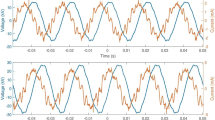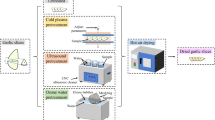Abstract
Anthocyanin-rich black rice powder was incorporated into bread, and the stability of two specific anthocyanins, cyanidin-3-glucoside and cyanidin-3-rutinoside, during baking was investigated. Various baking conditions included different baking temperatures (200, 220, and 240 °C) and baking durations (0, 2, 4, 6, 8, 10, and 12 min). Non-isothermal kinetic models were successfully established for the two anthocyanins in both bread crumb and crust. The derived degradation rate (k ref) of cyanidin-3-glucoside and cyanidin-3-rutinoside in bread crumb at the reference temperature (T ref) of 65 °C were 2.49 × 10−5 and 1.93 × 10−5 s−1, respectively. The k ref values of cyanidin-3-glucoside and cyanidin-3-rutinoside in bread crust (T ref = 125 °C) were 5.37 × 10−4 and 5.72 × 10−4 s−1, respectively. The color development of bread crust and crumb was measured and expressed as L*C*H ° values. While the color of bread crust was significantly subjected to variations in oven operating parameters, the color of bread crumb was relatively less affected by baking conditions. The antioxidant capacity and total phenolic content of bread samples were measured using DPPH and Folin-Ciocalteu assays, respectively. Results showed that in bread crumb, both the antioxidant capacity and the total phenolic content decreased; however, an increase in both was observed in bread crust.






Similar content being viewed by others
References
AOAC. (2000). Official methods of analysis of AOAC international (17th ed.). Gaithersburg: AOAC International.
Brand-Williams, W., Cuvelier, M. E., & Berset, C. (1995). Use of a free radical method to evaluate antioxidant activity. LWT - Food Science and Technology, 28, 25–30.
Bueno, J. M., Saez-Plaza, P., Ramos-Escudero, F., Jimenez, A. M., Fett, R., & Asuero, A. G. (2012). Analysis and antioxidant capacity of anthocyanin pigments. Part II: chemical structure, color, and intake of anthocyanins. Critical Reviews in Analytical Chemistry, 42, 126–151.
Cavalcanti, R. N., Santos, D. T., & Meireles, M. A. A. (2011). Non-thermal stabilization mechanisms of anthocyanins in model and food systems—an overview. Food Research International, 44, 499–509.
Chun, O. K., Chung, S. J., & Song, W. O. (2007). Estimated dietary flavonoid intakes and major food sources of U.S. adults. Journal of Nutrition, 137, 1244–1252.
Eliasson, A.-C. (2003). Utilization of thermal properties for understanding baking and staling processes. In G. Kaletunc & K. J. Breslauer (Eds.), Characterization of cereals and flours: properties, analysis and applications (pp. 65–66). New York: Marcel Dekker.
Fernandes, I., Marques, F., de Freitas, V., & Mateus, N. (2013). Antioxidant and antiproliferative properties of methylated metabolites of anthocyanins. Food Chemistry, 141, 2923–2933.
Feyissa, A. H., Gernaey, K. V., Ashokkumar, S., & Adler-Nissen, J. (2011). Modelling of coupled heat and mass transfer during a contact baking process. Journal of Food Engineering, 106, 228–235.
Fleschhut, J., Kratzer, F., Rechkemmer, G., & Kulling, S. E. (2006). Stability and biotransformation of various dietary anthocyanins in vitro. European Journal of Nutrition, 45, 7–18.
Harbourne, N., Jacquier, J. C., Morgan, D. J., & Lyng, J. G. (2008). Determination of the degradation kinetics of anthocyanins in a model juice system using isothermal and non-isothermal methods. Food Chemistry, 111, 204–208.
Hendry, G. A. F., & Houghton, J. D. (1996). Anthocyanins and betalains. In G. A. F. Hendry & J. D. Houghton (Eds.), Natural food colorants (2nd ed., p. 261). Glasgow: Blackie Academic and Professional.
Hernández-Herrero, J. A., & Frutos, M. J. (2014a). Effect of concentrated plum juice on physicochemical and sensory properties of yoghurt made at bench-top scale. International Journal o f Diary Technology, 67, 123–128.
Hernández-Herrero, J. A., & Frutos, M. J. (2014b). Color and antioxidant capacity stability in grape, strawberry and plum peel model juices at different pHs and temperatures. Food Chemistry, 154, 199–204.
Holtekjølen, A. K., Bævre, A. B., Rødbotten, M., Berg, H., & Knutsen, S. H. (2008). Antioxidant properties and sensory profiles of breads containing barley flour. Food Chemistry, 110, 414–421.
Homann, J.-P. (2009). Color theory with realistic colors. In J.-P. Homann (Ed.), Digital color management: principles and strategies for the standardized print production (p. 44). Berlin: Springer.
Jiménez, N., Bohuon, P., Dornier, M., Bonazzi, C., Pérez, A. M., & Vaillant, F. (2012). Effect of water activity on anthocyanin degradation and browning kinetics at high temperatures (100–140 °C). Food Research International, 47, 106–115.
Kırca, A., Özkan, M., & Cemeroğlu, B. (2007). Effects of temperature, solid content and pH on the stability of black carrot anthocyanins. Food Chemistry, 101, 212–218.
Konczak, I., & Zhang, W. (2004). Anthocyanins—more than nature’s colors. Journal of Biomedicine and Biotechnology, 5, 239–240.
Lee, J. H. (2010). Identification and quantification of anthocyanins from the grains of black rice (Oryza sativa L.) varieties. Food Science and Biotechnology, 19, 391–397.
NPCS Board of Consultants and Engineers. (2011). Handbook on fermented foods and chemicals. Delhi: Asia Pacific Business Press.
Patras, A., Brunton, N. P., O’Donnell, C., & Tiwari, B. K. (2010). Effect of thermal processing on anthocyanin stability in foods; mechanisms and kinetics of degradation. Trends in Food Science and Technology, 21, 3–11.
Peng, X., Ma, J., Cheng, K.-W., Jiang, Y., Chen, F., & Wang, M. (2010). The effects of grape seed extract fortification on the antioxidant activity and quality attributes of bread. Food Chemistry, 119, 49–53.
Purlis, E., & Salvadori, V. O. (2007). Bread browning kinetics during baking. Journal of Food Engineering, 80, 1107–1115.
Purlis, E., & Salvadori, V. O. (2009). Modelling the browning of bread during baking. Food Research International, 42, 865–870.
Purlis, E., & Salvadori, V. O. (2010). A moving boundary problem in a food material undergoing volume change—simulation of bread baking. Food Research International, 43, 949–958.
Reyes, L. F., & Cisneros-Zevallos, L. (2007). Degradation kinetics and color of anthocyanins in aqueous extracts of purple- and red-flesh potatoes (Solanum tuberosum L.). Food Chemistry, 100, 885–894.
Rodriguez-Mateos, A., Cifuentes-Gomez, T., George, T. W., & Spencer, J. P. E. (2013). Impact of cooking, proving, and baking on the (poly)phenol content of wild blueberry. Journal of Agricultural and Food Chemistry. doi:10.1021/jf403366q.
Rodriguez-Saona, L. E., & Wrolstad, R. E. (2001). Extraction, isolation, and purification of anthocyanins. In R. E. Wrolstad (Ed.), Current protocols in food analytical chemistry. New York: Wiley.
Rubinskiene, M., Jasutiene, I., Venskutonis, P. R., & Viskelis, P. (2005). HPLC determination of the composition and stability of blackcurrant anthocyanins. Journal of Chromatographic Science, 43, 478–482.
Ryckaert, V. G., Claes, J. E., & Van Impe, J. F. (1999). Model-based temperature control in ovens. Journal of Food Engineering, 39, 47–58.
Sharma, A., & Zhou, W. (2011). A stability study of green tea catechins during the biscuit making process. Food Chemistry, 126, 568–573.
Shibukawa, S., Sugiyama, K., & Yano, T. (1989). Effects of heat transfer by radiation and convection on browning of cookies at baking. Journal of Food Science, 54, 621–624.
Shipp, J., & Abdel-Aal, E.-S. M. (2010). Food applications and physiological effects of anthocyanins as functional food ingredients. Open Food Science Journal, 4, 7–22.
Slavin, M., Lu, Y., Kaplan, N., & Yu, L. (2013). Effects of baking on cyanidin-3-glucoside content and antioxidant properties of black and yellow soybean crackers. Food Chemistry, 141, 1166–1174.
Sólyom, K., Solá, R., Cocero, M. J., & Mato, R. B. (2014). Thermal degradation of grape marc polyphenols. Food Chemistry, 159, 361–366.
Sui, X., & Zhou, W. (2014). Monte Carlo modelling of non-isothermal degradation of two cyanidin-based anthocyanins in aqueous system at high temperatures and its impact on antioxidant capacities. Food Chemistry, 148, 342–350.
Sui, X., Dong, X., & Zhou, W. (2014). Combined effect of pH and high temperature on the stability and antioxidant capacity of two anthocyanins in aqueous solution. Food Chemistry, 163, 163–170.
Tan, M. Y., & Zhou, W. (2009). Modelling of bread colour development during baking. Food Manufacturing Efficiency, 2(2), 9–15.
Therdthai, N., & Zhou, W. (2003). Recent advances in the studies of bread baking process and their impacts on the bread baking technology. Food Science and Technology Research, 9, 219–226.
Tsuda, T. (2012). Dietary anthocyanin-rich plants: biochemical basis and recent progress in health benefits studies. Molecular Nutrition and Food Research, 56, 159–170.
Vera de Rosso, V., & Mercadante, A. Z. (2007). Evaluation of color and stability of anthocyanins from tropical fruits in an isotonic soft drink system. Innovative Food Science and Emerging Technologies, 8, 347–352.
Vhangani, L. N., & Van Wyk, J. (2013). Antioxidant activity of Maillard reaction products (MRPs) derived from fructose-lysine and ribose-lysine model systems. Food Chemistry, 137, 92–98.
Wang, W.-D., & Xu, S.-Y. (2007). Degradation kinetics of anthocyanins in blackberry juice and concentrate. Journal of Food Engineering, 82, 271–275.
Wang, R., & Zhou, W. (2004). Stability of tea catechins in the breadmaking process. Journal of Agricultural and Food Chemistry, 52, 8224–8229.
Wang, R., Zhou, W., & Jiang, X. (2008). Mathematical modeling of the stability of green tea catechin epigallocatechin gallate (EGCG) during bread baking. Journal of Food Engineering, 87, 505–513.
Waterhouse, A. L. (2001). Determination of total phenolics. In R. E. Wrolstad (Ed.), Current protocols in food analytical chemistry. New York: Wiley.
Wiczkowski, W., Topolska, J., & Honke, J. (2014). Anthocyanins profile and antioxidant capacity of red cabbages are influenced by genotype and vegetation period. Journal of Functional Foods, 7, 201–211.
Yang, Z., Han, Y., Gu, Z., Fan, G., & Chen, Z. (2008). Thermal degradation kinetics of aqueous anthocyanins and visual color of purple corn (Zea mays L.) cob. Innovative Food Science and Emerging Technologies, 9, 341–347.
Zhou, W., & Therdthai, N. (2007). Three-dimensional CFD modeling of a continuous industrial baking processes. In D.-W. Sun (Ed.), Computational fluid dynamics in food processing (pp. 288–289). Boca Raton: CRC Press.
Acknowledgments
Support from A*STAR through research grant SERC 112 177 0038 and the National University of Singapore (Suzhou) Research Institute under the grant number NUSRI2011-007 is gratefully acknowledged. The first author also likes to thank China Scholarship Council (CSC) and the National University of Singapore (NUS) for financial support.
Author information
Authors and Affiliations
Corresponding author
Rights and permissions
About this article
Cite this article
Sui, X., Yap, P.Y. & Zhou, W. Anthocyanins During Baking: Their Degradation Kinetics and Impacts on Color and Antioxidant Capacity of Bread. Food Bioprocess Technol 8, 983–994 (2015). https://doi.org/10.1007/s11947-014-1464-x
Received:
Accepted:
Published:
Issue Date:
DOI: https://doi.org/10.1007/s11947-014-1464-x




